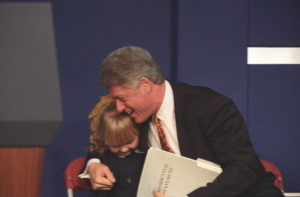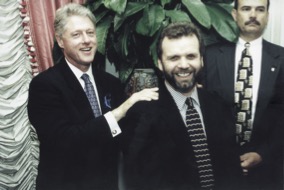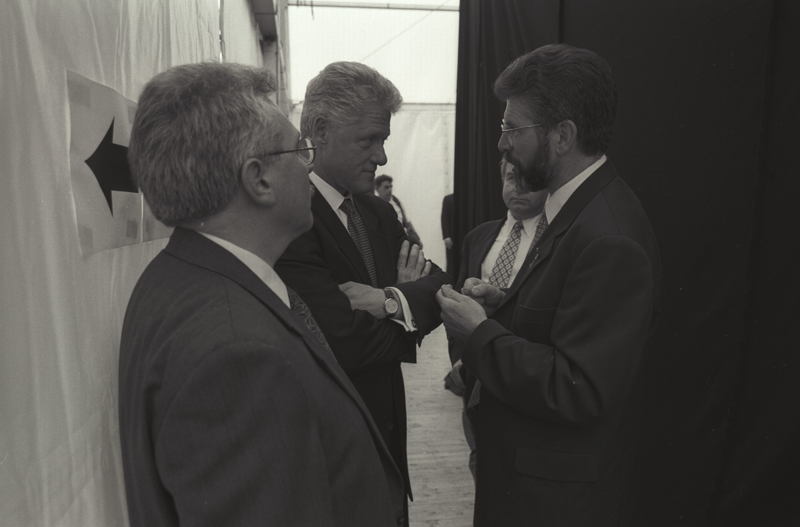President Clinton’s Commitment to Ireland
The White House economic conference on Ireland on May 24-26, 1995 will be the latest in a series of Irish initiatives by President Clinton. Niall O’Dowd reports on the making of a new “special relationship.”
On May 24 President Bill Clinton will become the first U.S. president ever to deliver a major speech on Irish issues when he addresses over 1,000 delegates to the first-ever White House economic conference on Ireland.
The conference, to be held at the Sheraton Washington Hotel in the nation’s capital over a three-day period, will also be the first time that any American president will commit his administration to the kind of direct economic and political involvement in the affairs of Ireland since the dawn of the American Republic.
Clinton called the conference after appointing the former Majority Leader in the Senate, George Mitchell, as his economic envoy to Ireland. Although appointed for only a four-month period, Mitchell will likely end up serving in the post until close to the end of 1995.
Last November he and Secretary of Commerce Ron Brown traveled to Ireland, North, and South, to explore ways in which the peace process could be helped by American economic investment and input.
Clinton, his Secretary of State Warren Christopher, and his Secretary of Commerce Ron Brown will all speak at the conference proper which will also be attended by the Northern Secretary of State Sir Patrick Mayhew and Irish Foreign Minister Dick Spring.
The economic conference is just the latest example of the commitment that President Clinton has to Ireland and particularly to the peace that he has helped bring about. Indeed, without his involvement, it is very likely that we would not be looking at the greatest opportunity for peace in Ireland in this generation.
Since assuming power in January 1993, President Clinton has set about building a new “special relationship” with Ireland and the Irish in America, which has eclipsed the historical “special relationship” with Britain in many cases when the two countries have come into conflict.
While the British have opposed the new line from the White House, bitterly fighting the visas for Sinn Fein leader Gerry Adams and other leading Sinn Fein members, and constantly trying to undercut Clinton in the establishment British media, the attempt has failed and the president has seen the impact of his new line on Ireland work with spectacular success.
We can take no less authority than the IRA for that. In a secret IRA memo revealed by journalist Ed Moloney in the Sunday Tribune in Ireland on April 23, the reasons for the IRA ceasefire of August 31, 1994, were detailed. Among the three key reasons given was the support of President Clinton for the new peace process. The document also states in part:
“There is potentially a very powerful Irish American lobby not in hock to any particular party in Ireland or Britain … Clinton is perhaps the first U.S. president in decades to be substantially influenced by such a lobby.”
The other two major reasons cited were the support of Nationalist political leader John Hume and the backing of the Irish government, then led by Albert Reynolds, for the process.
New Taoiseach (Prime Minister) John Bruton who took over from Reynolds has also made clear the value of the Clinton role. Speaking at the White House on March 17 at a reception in his honor, Bruton hailed Clinton as “a risk-taker, who took risks for peace.”
Bruton candidly admitted that he had opposed a U.S. visa for Sinn Fein leader Gerry Adams in January of 1991 when the IRA campaign was still going on. “But I was wrong Mr. President, and you were right,” he told Clinton before an invited guest list of 300 Irish American community leaders. “We have you to thank for this peace process,” he told a beaming president.
Just how far the U.S. has come in taking an active hand in bringing peace to Ireland under Clinton can be gauged by the actions of his predecessors on the issue.
There have been American presidents before who addressed Irish topics, but it was mainly in the context of St. Patrick’s Day remarks, usually as innocuous as possible.

On one celebrated occasion in 1981, outside the usual St. Patrick’s Day orbit, Ronald Reagan addressed the American Irish Historical Society in New York at their 84th annual banquet. His opening lines were about the “Happy colleen of Ballisodare who lived among the wee people.”
Just one paragraph of his speech was devoted to Northern Ireland and it consisted mainly of the following remarks: “I think we should pray that responsible leaders on both sides and the governments of the United Kingdom and the Republic of Ireland can bring peace to that beautiful isle once again.”
Prayer alone was never going to work, especially as Reagan was speaking at a time when the H Block hunger strikes which led to the death of Bobby Sands and nine others were totally dominating the Irish agenda. A word from Reagan to his best pal Margaret Thatcher to somehow find a solution to the impasse would very likely have headed off the crisis, but none was forthcoming.
But it would be very wrong to blame Reagan entirely as he was operating in an era where the links between the British government and their U.S. counterparts, particularly the State Department, were so binding that the joke was that State Department clocks were set on London time.
The “special relationship” between the two sides was cemented in the wake of World War II when the two allies stood up against fascism and fashioned an alliance that was the most powerful war machine the world had ever seen.
For the next almost 50 years the British and U.S. governments worked for hand in glove on every major international crisis affecting both countries.
The relationship reached its zenith under Reagan and Margaret Thatcher when the two ideological soul-mates formed a perfect partnership. When Ronald Reagan wanted to bomb Libya after the terrorist killing of a U.S. serviceman, he used Britain as his military launching pad, courtesy of Thatcher.
When Reagan retired he was given an honorary knighthood by the Queen to mark his services. While the knighthood stuck in the craw of some Irish Americans, especially as he was one of their own, ideological and global political reality always emphasized the U.S./British ties to the exclusion of Irish government/Irish American interests.
The end of the Cold War, however, brought about a fundamental change in perception. No longer was there an evil empire for the two countries to battle together and suddenly Britain was the “sick man of Europe,” in sharp economic decline and unpopular with its NATO and European Community allies because of the constant bickering over European defense and economic policy.
Domestic political considerations in Britain drove the debate. European ties were highly controversial in the Conservative party because of the loss of sovereignty it entailed. Suddenly nations like reunited Germany loomed as more important strategic partners for the U.S. than the increasingly isolationist British.
Then there was the political difficulty that the Conservative government landed itself in during the run-up to the last presidential election.
Lulled into a false sense of security by their close ties to successive Republican administrations, and the seeming invincibility of their close ally George Bush after the Gulf War, the Tories discovered too late that they had too lightly regarded the young governor of Arkansas, Bill Clinton, who was suddenly looming as a major threat to Bush.
The Tories then set about blatantly interfering in the American electoral process, dispatching two top political aides to the Bush campaign and allowing a search of their own passport files at Bush’s behest, to check to see if Clinton had applied for British citizenship during his time at Oxford University to avoid being drafted in the Vietnam War.
Finally, on the eve of the election, a “Dear George” letter from British Foreign Secretary Douglas Hurd, wishing him the very best result in the election, was made public to the obvious annoyance of the Clinton camp.
Thus, on November 4, 1992, the day after the presidential election, Downing Street woke up to a very uncomfortable new political reality in Washington. Their horse had finished a poor second — and they had obviously and publicly backed it while attempting to hobble the winner.
Clinton was not about to forget either. The New York Times Magazine, in one of the first profiles after his election, rated the British leader John Major as the highest on Clinton’s dislike list because of his election interference.
On the other hand, the Irish American lobby had managed to reach out to a political candidate early, and their courtship was about to pay off in spectacular fashion.
The first approaches had been made when Clinton was still a medium-sized blip on the campaign screens in New Hampshire. The campaign managers of Clinton, and the other leading candidates, Paul Tsongas and Senator Bob Kerrey, were contacted and given a wish list of Irish American priorities.
Former Congressman Bruce Morrison, a hero to the Irish because of his “Morrison visa” immigration reform package which provided over 50,000 young Irish with green cards and who would later play a huge role in Clinton’s Irish outreach, remembers that the choices were stark.
“We had Bush who was totally a cat’s paw of the British on Northern Ireland and we had a Democratic candidate, still unknown, who we knew could not be any worse. Not surprisingly, we decided to try and work with the Democrats.”
Since assuming power in January 1993, President Clinton has set about building a new “special relationship” with Ireland and the Irish in America, which has eclipsed the historical “special relationship” with Britain.
Arising out of the contacts and a favorable response from the Clinton campaign which detailed Chris Hyland, a New York-based interior decorator and “Friend of Bill” as the organizer of Irish ethnic outreach, an organization called “Irish Americans for Clinton” was formed.
It met for the first time in February 1992 when Clinton was still in deep difficulty in New Hampshire. The co-chairs selected were Bruce Morrison, a former Yale Law School classmate of Clinton, and Boston Mayor Ray Flynn, a doughty fighter on Irish issues for decades and, crucially, an important Irish Catholic supporter of Clinton who desperately needed the white ethnic “Reagan Democrat” vote to return to its Democratic roots.
Events moved quickly once Clinton passed the New Hampshire hurdle and established himself as the Democratic front-runner. A key element of the jigsaw puzzle was provided via Senator Edward Kennedy when his former staffer on Irish issues, Nancy Soderberg, was appointed to the Clinton foreign policy team. Suddenly there was someone on the campaign staff who had an intimate knowledge of the Irish issue.
In addition, Senator Kennedy himself and his foreign policy aide, Trina Vargo, were liaising closely with the Clinton team on the Irish question. Kennedy and the more militant Irish American lobby worked out a series of campaign positions the major element of which they could all agree on, though there were still differences in emphasis. For the first time in decades, there was unity in Irish American political circles.
When the Democratic candidate attended an Irish issues forum during the New York primary and laid out his campaign promises on Ireland, the activists could not have been happier. The main planks Clinton came out in favor of were a U.S. peace envoy for Northern Ireland, a visa for Gerry Adams, a commitment to raise the issue of human rights abuses, and support for the MacBride Principles. Clinton reiterated his support for those issues in a subsequent interview with the Irish Voice newspaper.
The Irish lobby raised funds, organized political support, and backed their man through the primaries and the general election. On November 4 they too woke up to a new landscape. After decades of seeing their candidates flounder, they had, at last, backed a winner. Now would he deliver, or would the old “special relationship” take over?
It took almost a year to really find out. The Gerry Adams visa was the prime test. Throughout 1993 events were moving quickly in Northern Ireland and it became clear that the permafrost of 25 years was melting under the white heat of political progress.
The movement began when Sinn Fein leader Adams and his moderate Nationalist counterpart John Hume reached an agreement on a common way to approach the problem of Northern Ireland. The mutual accommodation between these long-time political rivals sent shock waves through a political system that had been clogged for a quarter-century.
Then the new Irish Prime Minister Albert Reynolds and his British counterpart John Major reached an agreement on a set of outlined principles on how to proceed jointly on Northern Ireland. Called the Downing Street Declaration, the document was a crucial signpost for the future.
Now it was time for America to lend a hand. Gerry Adams was trying to move his party and the IRA away from violence to a political stance. A key part of that process was breaking down the 25-year wall of silence which had been imposed on Sinn Fein internationally by successive U.S. and British governments. Adams had never been to the U.S. and was banned from the airwaves in Ireland and Britain.

The application for the visa was the first test of the new administration and Clinton’s willingness to deliver on its Irish promises. It was opposed vigorously by the British government and supported by the Irish lobby and by Senator Edward Kennedy, his sister Ambassador Jean Kennedy Smith in Dublin, and other leading Irish American politicians.
For the first time ever an American president picked the Irish lobby over the British argument that strategic issues and the “special relationship” should always dominate the U.S./British/Irish axis.
Adams’ visit to the United States may have moved the peace process up by at least a year, according to one source. It was a vital breakthrough for Adams and made his own task internally that much easier. The international wall of isolation was cracked forever.
Suddenly there was an international dimension to the Irish struggle; the most powerful elected official in the world had sided with the Irish Nationalists’ lobby, led by the Irish government, over the British.
The British reaction was one of fury. Their newspapers lambasted Clinton and their Ambassador to the U.S. Sir Robin Renwick described Adams as “Goebbels.”
But their fury had as much to do with the death of the “special relationship” as it had with anything Adams had accomplished. The good old days of the Reagan/Bush/Thatcher troika were gone forever and in its place was a U.S. president who owed them nothing.
More importantly, the perennial battle within the White House for the ear of the president on foreign policy had been lost by the State Department, traditionally the major promoter of British policy in U.S. administrations.
Instead, the nexus of power had shifted to the pro-Irish National Security Council where long-time Kennedy staffer Nancy Soderberg was installed as Chief of Staff, and to the powerful Irish American lobby on Capitol Hill led by Senator Edward Kennedy and Senator Chris Dodd of Connecticut.
In the Adams visa battle, the National Security Council and the Irish lobby had outsmarted the State Department and the British to win the visa. The consequent success of the visa policy, after it was widely seen as a major step in bringing about the IRA ceasefire, was a further boost to those close to the president who had promoted it and further strengthened the pro-active Irish policymakers.
Since then Clinton has moved quickly to consolidate his Irish agenda. On March 17, 1994, he threw open the White House for an Irish party that will never be surpassed in those hallowed halls. From every walk of life successful Irish Americans came at the invitation of the president and many thanked him for his role in the developing peace process.
Then Taoiseach Albert Reynolds, who had become as frequent a foreign visitor to the White House as any other world leader, praised Clinton lavishly for his role. The Irish never had it so good in Washington, he told the assemblage.
On August 31 last year, the IRA ceasefire was announced. A few days later, Clinton broke his Martha’s Vineyard vacation to meet with Irish Foreign Minister Dick Spring to discuss the implications. His hands-on approach sent a very strong signal of his continuing interest.

In 1995 Clinton continued his special Irish relationship. The May economic conference will be the latest in a series of initiatives that have already marked him down for all time as the man in the White House who did the most for Ireland.
In addition, he allowed Sinn Fein leader Gerry Adams to fundraise in the U.S and greeted him at the White House this March 17, to the chagrin of the British.
Whether it is political expedience with an eye to the 1996 election, whether it is his mother’s Cassidy roots or the MacBride roots on his father’s side, or whether it is a genuine altruistic sense that he can do good in a part of the world hitherto neglected by America, may well be irrelevant. Clinton has done the Irish proud and in the process has built a special relationship for the ages. ♦
Editor’s Note: April 2023 was the 25th anniversary of the Good Friday Agreement. While Presidents Joe Biden and Bill Clinton traveled to Northern Ireland to commemorate the historic agreement Irish America Publisher Niall O’Dowd The Guardian podcast Politics Weekly America to discuss his role in helping to connect the people that ultimately brought the Good Friday Agreement to fruition. Listen to the podcast.


Leave a Reply